#but the color is doing most of the work to distinguish the two!
Text
If, as Isaac West observes, use of the public bathroom is “one of the most, if not the most, quotidian practices of citizenship,” then this chapter argues that surveillance criminalizing public bathroom use is one element of a larger effort to secure citizenship and spatial belonging through the apprehension of physical difference. [...]
Writing about the concept of civilization in the late nineteenth-century United States, Gail Bederman describes it as an “explicitly racial concept” that “denoted a precise stage in human racial evolution”: one that had evolved past primitive or barbaric characteristics. Drawing on Darwinism, this logic rationalized white supremacy through claims that people of color simply had not developed in the same ways or at the same rate as white people, situating civilization itself as a racial characteristic and producing and solidifying distinct racial categories. Bederman notes that gender was crucial in distinguishing civilized societies from the less advanced, with the former identified in part by clear binary gender divisions. [...] Moreover, in the era of formal Jim Crow, while bathrooms marked for white people were typically separated into men’s and women’s spaces, those labeled “colored” were often unmarked by gender at all, a practice that aligns with civilizational discourse. [...]
Yet citizenship status and gender status cannot be pulled apart [...]: just as the previous two chapters of this book traced specific aspects of the Department of Homeland Security that produce and rely on a gendered citizenship, we might consider how campaigns for neighborhood safety and family values regularly invoke a kind of good citizenship that is determined in part through gender attributes. [...]
We need only consider the emphasis on birth certificates to understand the extent to which anxieties about citizenship undergird these bathroom scenes, since those documents mark not only state-approved sex designation, but also legal citizen status. In the most formal sense, birth certificates purportedly confirm citizenship and thus one’s legal belonging to the nation-state. At the same time, they can serve as evidence of citizenship in a more informal or cultural sense: if producing appropriate paperwork is one way of complying with state regulations and requests, then doing so performs good citizenship. [...]
Discourses of bathroom contagion merge fears of “real germs” with “the fear of the other”; hence, public toilets provoke more anxiety than other germ-riddled public objects like computer terminals and doorknobs. Concerns about bathroom cleanliness are as much about bodily interactions and the difficulty of regulating public space as they are about actual dirt or waste. The racial integration of some U.S. workplaces during World War II, for example, prompted tremendous white anxiety about shared bathrooms, even as Black people had long cleaned toilets and beds, prepared food, and cared for children as part of their domestic work in white households. But this “private service work reinforced racialized gender hierarchies in ways that public intimacy undermined them.”
— Toby Beauchamp (2019), Going Stealth: Transgender Politics and US Surveillance Practices, pp. 81 - 101
In his book, Beauchamp argues that anti-trans bathroom bills should be understood as a form of state surveillance that is inextricable from anti-immigration and border security practices: these bills deputize members of the public to conduct bodily assessments of other people to determine whether they meet the criteria of a 'good citizen,' giving them the power to report 'fraudsters' to the authorities if a transgender person is found inhabiting a public bathroom. The criteria by which these assessments are conducted are explicitly white supremacist ones; not only because the imagined body of the 'good citizen' is one that reflects the ideals of white, bourgeois, cissexual bodies* (as clearly demarcated, binary gender roles is a sign of advanced white civilization, and perversion of these demarcations is a perversion of white civil life), but also because one of the primary forms of evidence that you belong in a gender-segregated public space (such as a bathroom) is a birth certificate, one issued by the state - as he says: "if producing appropriate paperwork is one way of complying with state regulations and requests, then doing so performs good citizenship." (p 93). Beauchamp criticizes the framing that trans people are treated like "second class citizens," as it accepts the white racial imaginary of (white) trans people being unfairly denied the benefits of full white citizenship; we should therefore understand gender segregated spaces not as a "remix" of "old" "historic" forms of racial segregation, but as a contemporary enforcement mechanism of it. Binaohan emphasizes this in their 2014 book Decolonizing Trans/Gender 101, arguing that non-white trans people are always "in public," denied any sort of private realm; they are always visible and marked as potential threats to white citizenship. (p. 39)
This is likewise reflected in Jenny Evang's 2022 work Is Gender Ideology Western Colonialism?, where she argues that anti-trans discourse situates the presumed natural state of 'sex' as being corrupted by an overly decadent form of Western cultural advancement, which is both degenerating the Western world and 'duping' the Global South into forsaking their relationship with nature, an argument that "[frames] “non-Western societies” as “more traditional” when it comes to gender, sexuality, and the family, since “gender ideology” has not yet gone as far there as in the West. Thus their argument relies on essentializing the very same conceptualization of “cultural difference” that structures femonationalist arguments in the first place, namely, that racialized, imagined elsewheres are stuck in a more traditional gender pattern, unable to keep up with the rampant development of the West." (p. 370). Locating the origin of transgenderism in the West reproduces notions of civilizational development, where the West is secure in its supreme cultural position but has merely gone "too far," "in the wrong direction," creating the circumstances of its own downfall - a downfall which is attributed both to mass immigration (particularly immigration of Muslims) and Marxism. (p. 372)
Fears of 'gender ideology' engulfing the Western world are inextricable from concerns about the maintenance of white social hygiene, as 'gender ideology' has been called "Ebola from Brussels" (p. 371), linking the corruption of binary, hierarchical, cissexual gender to a disease afflicting the body-politic of the white nation-state. The last paragraph of the quoted passage above from Beauchamp further demonstrates the fundamental interconnectedness between race, gender, and hygiene: The racial integration of some U.S. workplaces during World War II, for example, prompted tremendous white anxiety about shared bathrooms, even as Black people had long cleaned toilets and beds, prepared food, and cared for children as part of their domestic work in white households. But this private service work reinforced racialized gender hierarchies in ways that public intimacy undermined them." (p. 101) Discourses regarding public hygiene are civilizational discourses, as a clean world is a civilized world, and a civilized world can only be a white world.
*Beauchamp explicitly brings up that one of the 'problems' of using biometric data to scan the public for potential terrorists or 'fraudulent citizens' is the white inability to tell the difference between people belonging to different racial groups, i.e., the idea that all non-white people look too much alike and therefore must undergo even more intense scrutiny (p. 95).
96 notes
·
View notes
Text
bg3 modern!au idea where halsin is a conservationist, who mentions kind of despairingly to a younger colleague at a conference the way he's having such a hard time with outreach to get folks in his community aware of the wildlife around them and how important it is. the colleague makes an offhand reference to how tiktok is the way people seem to get connected to that sort of thing most nowadays, although hell if they have the patience to figure out the app, and wanders off to catch up with someone else. they will not realize until later (far, far later) the ramifications of this statement.
halsin is rather quiet for the rest of the event, makes his goodbyes, and then returns home to painstakingly research just how "tiktok" works, with the grim determination of a fighter entering the ring. if this is what it takes to raise awareness, then this is what he'll do. the cause is more than worth it.
the first roadblock he runs into makes him worry the venture will be over before its even started. the first few webpages he finds tell him patronizingly that his phone is too old to work for 'content creation'. and okay, so it's scuffed, and dented, and has maybe taken one or two tumbles into a mud puddle, but it ought to be more than serviceable! he goes outside and finds a patch of wildflowers, pulling up the camera function and shooting a shaky video. he returns to his kitchen table, squinting down at the results. he can see all of the distinguishing features of the plant that would allow him to recognize it in the wild, which means it's good enough to do its job. with a new resolve - that his family would have wryly labeled as stubbornness - he focuses his research efforts until he finally finds a webpage that will tell him how to make the app work with his phone.
when at last it starts up in a blare of sound and over-saturated colors, he grimaces, but presses on. it asks him to set up a username, and he types in his first name. the little circle spins for a moment, then tells him it's taken. he frowns, then adds a random number. 2. it spins again, same response. he frowns harder, then adds another. 6. it spins, spins, spins, then — welcome, new user @.halsin26! upload your first video to start using tiktok!
he decides not to overthink it. it'll either work out or it won't. he looks out the window, and judges there's still just enough light out. he returns to the little patch of wildflowers, and gives it a thumbs up. he starts a recording directly in the app, making note of the 60-second time limit with a grimace. to make the most of the time he has, he doesn't bother with an introduction, just kneels down next to the cluster of plants, careful not to compress the ground too close to their root system, and moves his hand just behind the flowering portion to visually distinguish it, and act as a scale reference. he keeps his voice low, since he doesn't want to overshadow the content itself, and quickly lays out where folks could run into this plant, its importance to its local ecosystem, and ways they could help its conservation. the most important things the average person can do, he states passionately as the timer begins its final warning, is to document the locations where they find said plants, so that the areas can be marked for oversight and protection.
he doesn't bother to look back over the video before he posts it. he knows what he said, after all. he stretches his arms up above his head, then massages the back of his neck where the muscles are growing stiff. as he heads back inside to start dinner for himself, he tosses the phone into a basket on the counter and forgets about it.

the video languishes in the algorithm for the evening, until a random user gets distracted from scrolling away from the potato-quality wildflower video someone's grandma uploaded and chokes on their spit as forearms that very clearly do not belong to anyone's grandmother enter the frame, gently cupping the air around the flower.
god i wish that were me, they type before they can stop themself. debating whether to bother hitting send, they choke again as an absolutely unfair voice begins to narrate the ecological importance of this particular plant. the voice is smooth and deep, just above a murmur with a pleasant backing rumble. they have never given a moment's thought to plants in their entire life, but all of a sudden they are invested. they don't even notice when their thumb hits 'send' on their comment, too busy swiping over to the profile to see if there are any other videos. it's empty of literally everything, default user icon, only-barely-not-randomly-generated username, only one video posted earlier that day. they go back to the video and copy the link to send to their friends, needing someone - anyone - else to understand the experience they just had.
a few more interactions like that, and the algorithm takes notice. it bumps the video to a few more users outside of the current sphere, and those ones like it too. more importantly, they are very likely to share the video with others, increasing the engagement far beyond anything it had right to expect.
by two days later, when halsin remembers to actually check the thing, it is sitting at a comfortable 2500 likes, and there is a whole fleet of comments waiting for him to review. some of them - many of them, actually - don't seem that relevant at all, and he frowns, but then he sees a few that actually seem interested in more information on the plant he'd described, asking questions about how wide its range is, if it could be found in this or that coloration, etc. these he responds to swiftly, then grimaces as he runs up against a 'character limit'? who ever heard of such a foolish thing. after a moment of glaring down at his phone, he sees that it will allow him to answer by video, and does so, stepping onto his porch and zooming in on the plants. (this blurs them into barely discernible blobs of pixels, but he does not notice.)
still others are curious about what other plants and wildlife he might be able to share about, and he leaves short comments under each letting them know that he will plan to upload some more videos soon, if there is an interest. one user has left a comment that he almost files into his mental "ignore" category, but goes back to reread at the last moment.
not convinced this isn't one of those 'booktok bait' things again but i stg there's a big ass patch of those fuckers behind a parking lot somewhere around here?
halsin responds to this one with a video too. now that he's getting the hang of it, it's actually a bit more convenient than having to type everything out. he thanks the commenter for sharing, then asks if they might be willing to do him a favor sometime – only if it wasn't any trouble, of course! – and grab a video or two of the area they referenced, and share it with him — or their local wildlife foundation, at least.

a few days later, he opens the app to check in to find that he's been tagged in a video by some user. bemused, he clicks on the popup, and it takes him to a slightly shaky but pristine quality video of an empty lot filled with tall grass. the person filming moves a bit closer, then zooms in, and halsin spots multiple cluster of that recognizable wildflowers, before the video ends and restarts. there's no narration to this one, only a barely audible music wheel spinning in the corner. the caption on the video says, @.halsin26 just in case you're not actually some weird account for a fetish i haven't heard of before, here's some of those plants you mentioned looking for.
#okay i have more thoughts but stopping it here for now before i lose even more time#sparked from a convo with a friend and my brain latched on to it#as ever this was... meant to be a short little thing#no comment on how that worked out#voidling speaks#bg3#bg3 au#bg3 fic#halsin#bg3 halsin#halsin become a cult fave tiktoker with a dedicated fanbase#a beloved cryptid#im not really planning this as a ship thing but if you like the vibes of that please feel so free to run with it in that direction#i'd just love a tag if you do#my writing
123 notes
·
View notes
Text
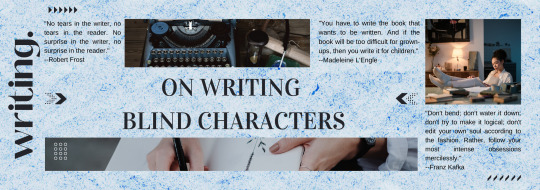
DECIDE 'HOW'
Decide how they went bind. Was it a disease or an accident? If it was a disease, you need to determine what it was. The disease you choose will affect your character's vision in a specific way.
Macular degeneration and retinitis pigmentosa will create two very different changes to vision. Get very specific with research.
If it was an accident, you need to get very specific about the details of that accident and research whether what you're suggesting is actually possible.
A head trauma might create a tear in the retina which would certainly affect vision, but retina tears are actually fixable through surgery in most cases (not all, but most).
A chemical burn would damage the layers of the eye enough to cause blindness, but you need to be specific on what chemical
it was, way type of burn it might cause, and how badly it would affect the skin surrounding the eyes.
Going the trauma/accident route is very easy to mess up and prone to being melodramatic. Choose well!
WHAT THEY SEE
Using what you've researched, decide exactly what your character sees.
Be very specific. Keep in mind that 90% of blind people at least have some remaining vision, even if it's very little.
It might be shadow and light perception, so they see more outside in the sun than they do at night. They can still be light sensitive if they have light perception.
They might see shadows moving in front of a light source, but see almost nothing at night. They may only see the light source (like lamp or headlights) and see darkness everywhere else.
Your character might have color vision still, or some vision acuity that allows them to distinguish some shapes from others but still prevents from seeing details.
Your character might have terrible depth perception, and this makes stairs and curbs impossible to perceive and they might knock something over because they perceived it as being farther away than it was, or feel frustrated when they reach for
something they though was a few feet in front of them and is actually closer to ten feet away.
See the World From Their POV
Put yourself in every scene or location your character will be in and determine what they can see in the moment. Even if you
are narrating from a different character's perspective, you need to know.
Using this, you need to know what your character knows, especially if your blind character is important to the plot. They
can't see the small print on that sign, the dried bit of blood on someone's shoes, a shadow sinking into an alley, or even if that
blurry blob twenty feet away is a trashcan or a person.
Make It Resonable
If your character is meant to be uncovering these clues, you need to find a reasonable way for them to figure it out.
Is there a sighted companion who points visual clues out to the blind partner? Do they have magnifiers to read small print?
Are they good at sneaking around and overhearing people from a distance? Are they just great and knowing when someone's lying by the tone of their voice?
Are they working with a team?
They don't necessarily have to have "superpowers" to figure things out!
The Narrative Voice
1st Person
This allows readers to inhabit the character and see what they see, or don't see.
You have to work in terms of what your character
can/cannot perceive, which can make description hard and can easily slip up and forget that your character can't see that street sign.
3rd Person
Your readers will probably forget how blind your character is if they read pages and pages with great visual description and then
be surprised when your character verbally remarks that they didn't see X and Y.
You still have to work with what they can realistically see and it's much easier to forget in 3rd person
If you like my blog, buy me a coffee! ☕
Have a writing question? My inbox is always open!
#writer#writers#creative writing#writing#writing community#writers of tumblr#creative writers#writing inspiration#writeblr#writing tips#writers corner#writers community#poets and writers#writing advice#writing resources#writers on tumblr#writers and poets#helping writers#writing help#writing tips and tricks#how to write#writing life#let's write#resources for writers#references for writers#writing prompt#on writing#writerscommunity#writers block#writerscreed
74 notes
·
View notes
Text
Day 13: learning a craft

Masterlist flufftober 🎀
Reblog if you liked it!
“Are you sure that's how it's done, Henry?” Spencer asked, evidently confused by the instructions his godson was giving him. The two of you had agreed to watch the little one for the afternoon when JJ would be busy and right now you were doing some origami.
You weren't very skilled at it, but compared to your friend you became an expert. Although, to be honest, you couldn't blame him too much, since you knew beforehand that Spencer had always been a little clumsy with manual activities. Still, you liked watching his hands working, almost as if it were a wonderful spectacle.
"Yes, uncle. You have to turn this part first and then the other…” the little boy began to say, guiding the man's hands himself until he managed to finish the dinosaur he was trying to make.
“Did you never make origami when you were a kid?”
"Not that I remember"
“It is a basic activity to develop children's motor skills. Maybe that's why you're so clumsy”
“Hey!” he complained, frowning at you and hearing you laugh afterward.
The two of you had a good relationship inside and outside of work, which allowed you to make those kinds of jokes, plus it was obvious to almost everyone that you had feelings for him. And if you didn't feel it, at least you pretended very well, always giving him compliments and looking for his company most of the time.
“I'm just telling the truth, handsome.”
“I may not know how to make it, but I know it originated in China around the 1st or 2nd century AD. C. arrived in Japan in the 6th century and it was then that he integrated into the Japanese tradition. In the Heian period, from 794 to 1185, origami was an important part of the ceremonies of the nobility, since folding paper was a luxury that only well-off people could afford. Then, in the Muromachi period, paper became cheap enough for everyone, and the origami style served to distinguish one social stratum from another, for example, between an aristocratic samurai and a peasant. But this art in the West is relatively recent”
“Only you, Spencer Reid, can be a genius who knows the origin of origami without knowing how to form a decent swan,” you murmured amused, while you proudly showed him your newly made work.
You and Henry continued making figures, until you saw your friend struggling too much with his sheet and, feeling sorry for him, you sat next to him on the floor to explain to him how to do it. Your hands were on his to show him how and where to turn and although he had wanted to deny it, he became slightly nervous because of the closeness that suddenly existed between you.
“What is this done for, anyway?”
“Because they are pretty and they entertain children a lot,” you replied, shrugging your shoulders as you showed him the duck you had finished “And I think the older ones too, huh?”
“I think it was frustrating me more than entertaining me, but I'm lucky you're here” he laughed, admiring the figure you had in your hands and looking at the many others that were on the table. Henry was in who-knows-where, probably in his room looking for more coloring pages, so you were left alone with Spencer on the living room floor.
“Well, then maybe this will make you feel better,” you murmured, searching through your creations until you found the right one; it was a pretty red heart, carefully folded and made especially for him, “I thought about making you a frog, but I figured you'd like this one better.”
“Are you trying to seduce me? Because I warn you that I am a difficult man."
“Oh, Reid, I don't think so,” you laughed, moving your face close enough to hear him swallow and see his cheeks flush. “I think a woman determined enough can dull that brain and make your heart race.”
Spencer wanted to say something else, but you were interrupted by Henry, who indeed returned with his hands loaded with materials for more crafts. The rest of the afternoon he kept watching you when you didn't realize it, knowing that at some point he would end up giving in to those flirtations of yours and you would end up being his complete downfall.

taglist: @navs-bhat @reidwritings @tricia-shifting14 @spencerslove @vivian-555 @r-3dlips @rhiannonhippiegirl @taygrls @simp4f1 @sdddoobydoobydoo @taintedstranger
#spencer reid#spencer reid fanfic#spencer reid x reader#criminal minds#criminal minds fanfic#dr spencer reid#matthew gray gubler#spencer reid x you#flufftober 2023#prompt list#writing challenge#spencer reid fluff#spencer reid fanfiction#criminal minds fanfiction#spencer reid imagine#spencer reid drabble
168 notes
·
View notes
Text
Some things about the frames in No Longer You!
Spoiler warning for the finale!
The first frame of Haley and the last frame of Sherb are different stylistically than the rest of the frames. The majority are in ‘prophecy-land’, which is inspired by a tapestry but it’s really to signify that this is not physically happening. Everyone in prophecy-land is silhouetted, and has one thing/color to help signify who they are. The exception for this is the wack, which is in color, because the wack isn’t something that’s supposed to be there/not from the world of Fable.
Song of past romance: Momboo! They were dating in s1, so she’s there. I chose her pink flowers in her hair. I knew I wanted something pink, and those made the most sense to me and tie into her being Lady of The World.
Sacrifice of Man: Jamie! When Icarus went and (tried to) kill Jamie, it felt the most like a sacrifice. It was the first time that Icarus went out, on their own, to deliberately hurt someone. I chose Jamie’s vines to be the color here, because they feel distinctive.
Portrayals of betrayal: coworkers! I really like this frame. Ari and Ven both betrayed the Grove to work for Fable, and then ended up betraying Fable at the end. And even though they didn’t betray Icarus specifically, he was still alone at the end. Originally, I was planning on using blue for these two because they’re both blue characters, but then it was too much. So I used yellow, which worked for a smaller area and also it’s Fable’s color.
Brothers final stand: This is Rae. This stream is called Brother’s Final Stand. I chose to do Rae’s horns, because they’re something that signify his connection to the End, and they are a distinguishing feature.
On the brink of death: Icarus is dying! And Centross is here. I wanted to include Centross in this, and this frame made that work! He’s got his scar across the eye, because I wanted to do something purple and doing all his scars would not have worked. Icarus has their eyeblood, because that’s how you can identify them. Shoutout to Abby amiactuallydoingthis for helping me figure out how this pose works- they needed to have a clear silhouette and Centross had to be catching Ic, but we needed to see Icarus’ chest.
Draw your final breath: Icarus falling, thinking they’re about to die. We can see the wack, and their wings are shut.
Man who gets to make it home alive, but it’s no longer: Icarixus!!!! Icarixus isn’t the same as Icarus- because at time of singing, Icarus has Sherbert’s eye in their head and is not fully Icarus, while Icarixus has both eyes back. Also, Icarixus has learned so many things- not to trust Fable, about the worlds and the Sherbversions, about how the wack works and how they can help and hurt the other worlds. And they do get to make it home alive, after a bit. They get their glowy bird ears!
You: Icarus not in prophecy-land, but we see the tapestry falling behind them. Their eyes are colored, but nothing else is. Apart from the wack, this is the only time someone gets two colors, and I think that’s fun.
Thanks for reading! I thought a lot about what I put into these frames, so I wanted to share it somewhere.
If you want, check out all of my Fable animatics.
36 notes
·
View notes
Text
RAINBOW SIX OC: Lilja Järvinen
there it is a bit with lilja's bio that for sure it will not be completed fully as I want to make a sort of bio like r6s operators in future plus she doesnt have a reference draw for her yet so...I'll reblog if any change is made :D
---------------------------------
GENERAL INFOS
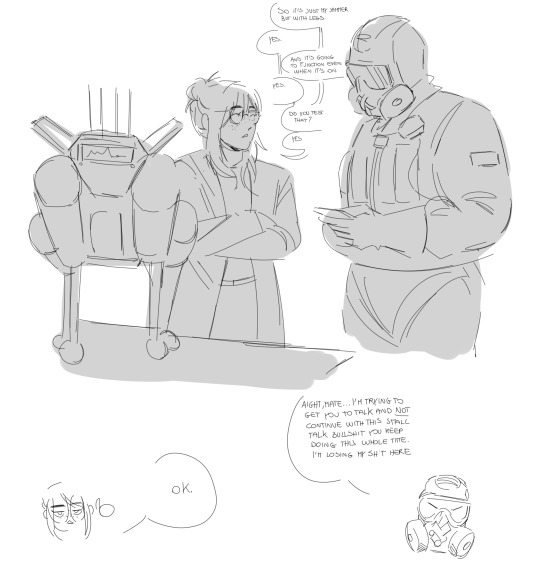
Full name: Lilja Järvinen
aliases/nicknames: One of the first thing that Harry did as soon as she joined the rainbow six is to think about how to refer to her and ''hound'' was what came into his mind immediately. Later then Lilja decided to just translate it into her native language, becoming it ''koira''but she likes the hound one as well
Age: around 30-35 years old
Gender: cis Female
Pronouns: she/her
Sexual orientation: Unknown, probably bisexual
Date of birth: April 30th
Place of birth: Rovaniemi, Laplan, finland
Current residence: Unknown
Nationality: finnish
Spoken languages: Finnish(main), Swedish(second one learned) and english
Affiliations/organizations: Rainbow six, utti jager regiment, finnish army
Occupation: K-9 operative with certification got with training and working with police and army dogs and robotic engineer with a egree in automation engineering, computer engineering
Rank: Unknown

(temporary reference)
APPEARANCE
By the national average, Lilja is a rather short woman who stands at around 166 cm tall. She is slim and athletic, with messy blonde hair, freckles scattered across her cheeks and nose, and eyes with partial heterochromia on both irises that are both blue and brown in color, which are easily distinguishable between the two. She is the one who usually wears heavy, long clothes that are uncomfortable when it comes to grabbing objects and that hide her body well. She wears glasses because she is astigmatic, which she removes to use contact lenses when she has to work in the field.
more facts about her aspect:
-Lilja has a lot of bite wounds on her body, done of course by the dogs she worked in the past with most of them being reactive ones that easily snapped when something even small bothered them. The most visible one is on her left cheek that resembles a two cut done by a feline instead of a dog and people usually asks her how could a dog do such damage;
-She always wanted a tattoo on her left cheek that resembled a dog jaw but changed her mind when she wasn't allowed to do so in the army.
-She doesn't hide her body due to insecurity, in fact, she also can wear swimming costumes and bikinis, she just prefers baggy clothes over normal ones.
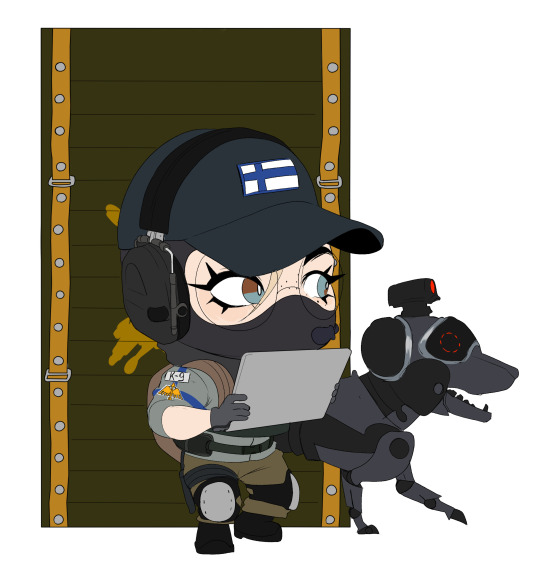
Favorites and personality traits
-Color: Mint green
-Food: Lihapullat (finnish meatballs)
-Drink: Hot chocolate
-Song: Killer by Mareux
-Flower: Lilly of the valley
-Hairstyle: wolfcut
Moral alignment: Chaotic good
MBTI: INTP
Personality overview:
Lilja is a reserved woman by nature, she doesn't like to talk to people too much and generally prefers to be alone. Sometimes she seems detached and lost in her thoughts, it almost seems like her brain is constantly working, constantly creating new thoughts. Which isn't necessarily a bad thing, as she always has new ideas that she can implement in the form of robotic objects useful to her team.
She seems to prefer small speeches to long, deep ones, which is often not in good taste with other operators and those in command, but she often ignore the thoughts of others.
This doesn't mean she's a totally insensitive person, she just doesn't know how to relate to people without seeming weird, which leads her to avoid social situations most of the time.
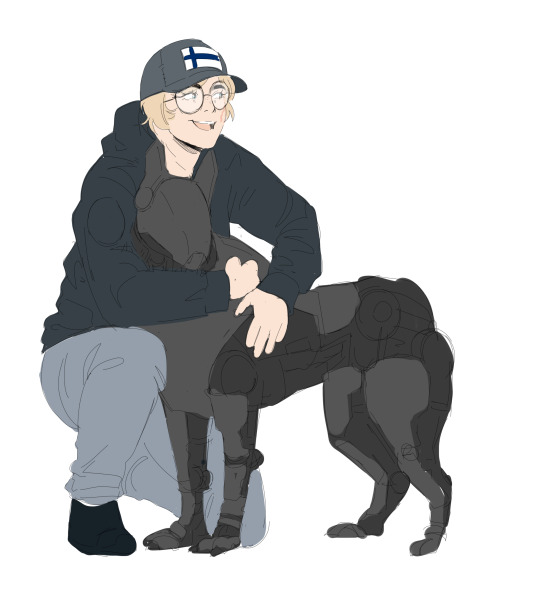
BASIC INFOS AS RAINBOW SIX OPERATOR:
Name: Lilja ''hound/koira''Järvinen
Side: defender
Squad: Nighthaven (she probably joined them because they were more willing to fund her projects)
Speciality: Anti-gadget, Intel and trapper
Unity: Utti jaeger regiment support battalion/support company-trains conscripts in support tasks and handles logistics in cooperation with the Logistics Centre.
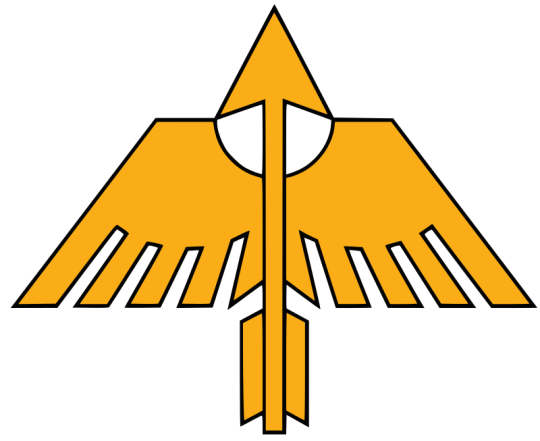
OPERATOR ICON:

BASIC LOADOUT
Primary weapons:
-Assault rifle, RK 95

-9.00 submachine gun 2000

-pump-action shotgun remington police

Secondary weapon:
-Pistol 80/Pistol 80-91

Gadgets
-Smoke grenade
-Frag grenade
-Claymore
LOADOUT PART 2:
Unique ability:
''K-9 puppies''
Highly intelligent robotic dogs with different speciality based on the selected one. They can be used as attack weapons, anti gadget, trapper or intel. They are all comanded by a tablet which makes you vulnerable to the attackers that can sneak and kill you.
The robotic dogs are not vulnerable to bulletts or explosives.
BIOGRAPHY
COMING SOON
PSYCHOLOGICAL REPORT:
COMING SOON
#original character#original characters#oc art#rainbow six oc#rainbow six fanart#rainbow 6 siege#rainbow six siege#oc biography
26 notes
·
View notes
Text

This week's Bestiary Posting is the Gerzlaem, and I can't wait to find out what it actually is. I can't even tell if this is a real critter or a mythical one. And I must apologize because it seems a lot of the warm tones in my piece got dulled down when I exported this - there's always a little bit of color difference, but for whatever reason this one suffered more than most and I don't have the patience to try and fix it.
The description tells us this creature has three varieties, but only describes two to us; a short, curly-haired one who is quite peaceable, and a tall, straight-haired one who is quite fierce. Kind of reminds me of how some sheep have hair instead of wool. I imagine the short one is about large dog sized with the larger one being the size of a black bear.
For having such a long description, there's not a whole lot to go off of this week. Reading it for the first time I actually thought it could be a winged creature, given that it is said to 'take flight', and was going for a sort of a giant harpy eagle azhdarchid, since it's described as eating apes. Clearly, I didn't go that direction, as rereading it, it seemed that 'flight' probably was being used to describe it fleeing on foot. Plus it was said to have paws and a long tail, so I opted to nix the flight idea. That said, I liked the shapes of the creature I originally sketched out, so I used that as my base. The beak was especially heavy in the front with the mouth turning up in a way that reminded me of gorgonopsids, so I leaned into that. I kept the floofy cheeks of the harpy eagle as well, which I think works well with the internal ears I went with. Sort of like how owls face feathers make a dish for collecting sound, the gerzlaem's floofy cheeks do the same for it. The internal ears, and the coloring I went with does also kind of make them look like seals with legs, which is a very fun idea.
The gerzlaem seems to be well regarded by the author - it's described as being compassionate, proud, strong, with courage in it's breast, resolution in it's head, and with a brow and tail that showed mettle. So I did my best to make a very handsome, noble-looking creature. Something that brought to mind big cats, bears, wolves and other big-brained charismatic megafauna we humans love so much. It's brow being described as showing mettle, I decided to give it very deep-set eyes to reflect this. It needed a large cranium, and intelligent eyes to fit it's compassionate, shy nature. I also think giving it a little beard makes it look very distinguished.
It's said to live amid the mountain peaks, so I decided to give it grippy little hoof toes, like wild sheep, but let it keep it's paw pads so it still has 'paws' as the description states. For coloration I went with a mix of greys and browns to better blend into the rocks of it's mountain home. Lastly, it has a long bushy tail to sweep the ground with, hiding it's tracks from any pursuers.
29 notes
·
View notes
Text












Scarlett's Scandalous Saga
This 1968 edition of Margaret Mitchell’s American Civil War-era novel Gone with the Wind was created for the Limited Editions Club and published in New York in a limited edition of 1500 copies. The two-volume work is signed by John Groth, an American illustrator and teacher best known for his depictions of combat, and Henry Steele Commager, an American historian who “helped define modern liberalism in the United States,” introduces the book.
John August Groth (1908-1988) produced more than one hundred fifty black-and-white drawings and twenty-one color illustrations, which were then turned into plates by Rainbows, Incorporated of Hazardville, Connecticut, and printed by The Holyoke Lithographing Company of Holyoke, Massachusetts. The text was set and printed at The Sign of the Stone Book in Bloomfield, Connecticut.
Book designer Ted Gensamer chose the font for the text, set in 10 pt. Janson and Jaguar script in various sizes for the display lines.
Margaret Mitchell (1900-1949), an American novelist and journalist, completed only one novel published during her lifetime. Her classic, sweeping epic Gone with the Wind was released in 1936. It won her the National Book Award for Most Distinguished Novel in 1936 and the Pulitzer Prize in 1937. This was after she spent ten years of her life writing the story out of boredom at home, recovering from a recurring ankle injury.
The book is not without its share of controversy. It has been the subject of intense debate, with its racist rhetoric and idealized portrayals of slavery coming under fire. Critics argue that it romanticizes the antebellum South and glosses over the horrors of slavery, depicting the Lost Cause as something heroic. While these criticisms are significant and should not be ignored, they do not detract from the novel's literary value. Instead, they spark critical reflection and discussion, inviting readers to engage with the text in a more nuanced way.
At its core, the story is a classic historical romance filled with love and heartbreak. It is a coming-of-age story about southern belle Scarlett O'Hara, a strong-willed, determined young woman who refused to bow to the patriarchy and societal standards of the time. The tale is set during the American Civil War and Reconstruction in Georgia, a period of substantial social and political upheaval. This context is central to understanding the characters' lives and their resilience and determination to survive and thrive in the face of adversity.
View more posts from the Limited Editions Club.
-Melissa, Special Collections Graduate Intern
#gone with the wind#Margaret Mitchell#John Groth#Henry Steele Commager#civil war#georgia#southern belle#controversial#banned books#scarlett o'hara#reconstruction#pulitzer prize#classic#historical romance#history#american novelist#racism#slavery#antebellum#american civil war#limited editions club#LEC
26 notes
·
View notes
Text
out of pure excitement, here's how the construction of a cuff-down sock works!
keep in mind this is just how I have made socks in the past and how I've seen them in patterns, this isn't the only way to do cuff-down socks :)
I'll also be using a picture I've already posted on here of a fully finished sock to use as a reference.
let's get started!
(very long post under the cut)
psst, ill be including a picture with a color coded section to help explain exactly where on the sock this is :)
part one: the cuff
the most obvious part of a cuff-down sock is - well - the cuff!
this is typically done with ribbing (though I've seen patterns without ribbing like this one), and I've found that for women's medium sized socks it's around 15-20 rows depending on the pattern and the knitters liking. this is one of the sections that's completely up to personal preference, as some like long cuffs, some like short cuffs, and some prefer no cuff at all :)
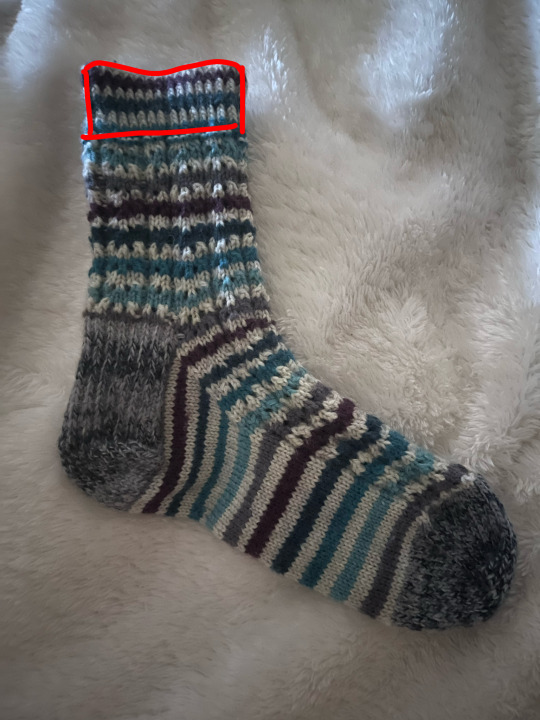
part two: transition row/s (optional)
some patterns utilize a transition row, especially if coming from some kind of ribbing to some kind of lace. this can help distinguish the cuff from the body of the foot, but isn't used in too many patterns that I've come across.
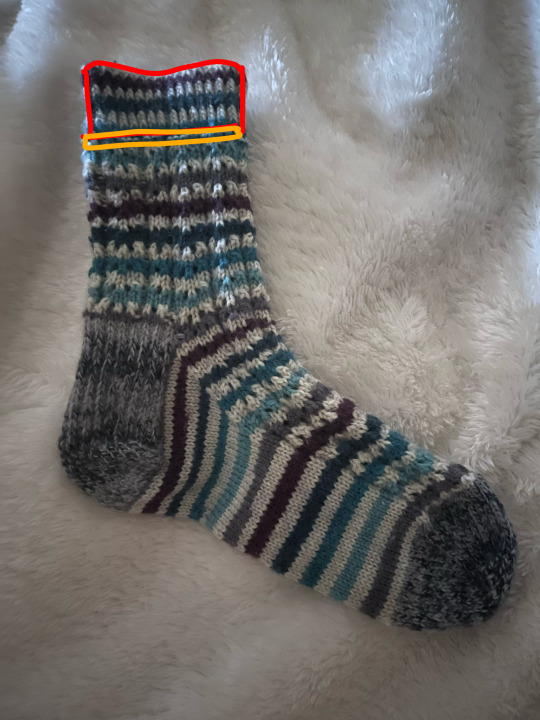
part three: leg section
stockinette, lace, cables, you name it! unless your sock is coming from your mid or high calf, you're not likely to have to increase/decrease this section at all. for the sock shown below, I stuck with all 66 stitches the entire way through :) (though be aware that some patterns do call for increases/decreases depending on length!)

part four: heel section
4a: heel flap
a heel flap is typically done across half, a third, or a quarter of the stitches used in the circumference of the sock, I prefer a reinforced heel flap (RS slip one purlwise, knit, continue to end of row ; WS purl until one stitch remaining, slip purlwise ; repeat until desired length), but there are many options out there for whatever you'd like!
most of the time you'll be making a heel flap kind of a square shape, working back and fourth until the end of the suggested rows or continuing until whatever length you'd like (though be aware that the longer it is, the more stitches you'll have around your heel circumference!!!)
4b: heel turn
a heel turn is really simple -- you knit until you're a bit past the middle of the heel flap (RS), ssk, k1, turn, slip 1, p however many stitches required (you can make a pointer or a more flat heel turn depending on the amount of stitches you use to begin with), p2tog, p1, turn, slip 1, knit until 1 before the "gap" that is formed, ssk, k1, repeat until you've finished picking up all stitches (you'll end up with less than your original stitch count, don't be afraid!)
by the way, there is this lovely video by heather storta on YouTube that explains all the different types of heels for cuff down, toe up, and after thought socks :)

part five: gussets & decrease section
5a: gussets (light blue)
the gusset stitches are all the stitches picked up from the sides of the heel flap -- when you slip the first stitch on each row, you create a selvage edge that you later knit from and then decrease from at the edge before the top of the foot until you reach your original stitch count! (the gusset stitches here would be at the edge of the green for the heel flap, the light blue is just showing the decrease section from the gussets as well :) )
5b: untouched foot section(??) (blue)
just as the title says, you don't mess with the stitch count of these areas. the top of the foot is left completely untouched, and besides the gusset stitch decreases on the sides of the back of the foot, it's otherwise untouched as well.
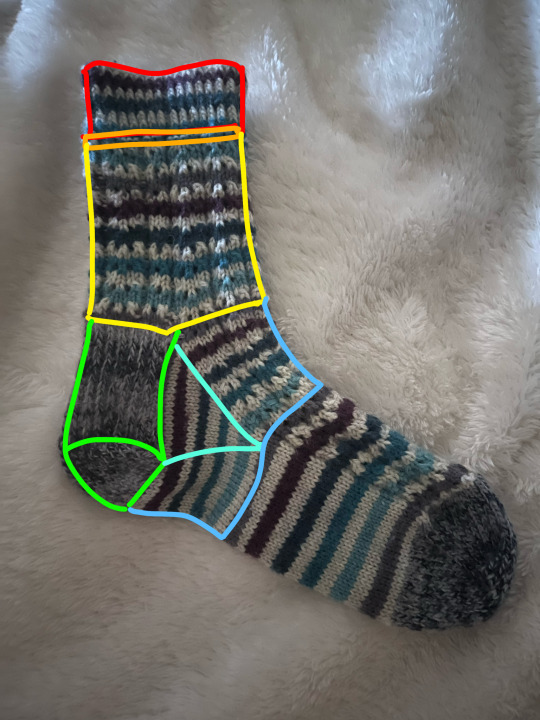
part six: the foot
as much as you may think that all of this is the foot, this is what I personally call The Foot Section - the length of one's foot is extremely varied, so this part is very much not something that can be easily standardized. I've found that measuring from the very back of my heel to the end of my big toe (and subtracting the length already knitting + the length of the toe + an extra 2ish cm) helps me get the perfect fit.
knowing your gauge and knowing your measurements is tantamount to having your own personalized pattern, so being if you want to make something that fits, you've gotta measure!
side note : it's normally suggested in patterns to subtract 2-2.5cm from your actual foot length, but always consult the pattern before deciding on anything in particular!
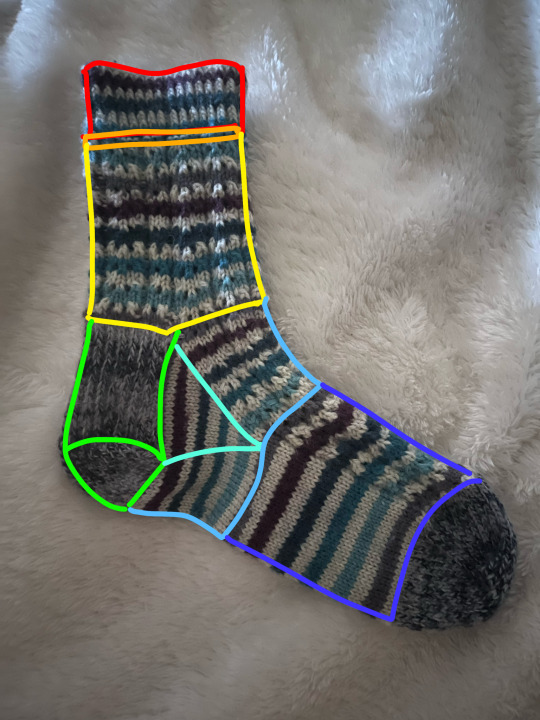
part seven: the toe
finally, we've reached the end! this is, in my opinion, the absolute easiest part of the sock. you're decreasing every other row (typically), which means every row gets shorter and shorter! personally, I get super motivated when I reach the toe section :)
there are MANY ways to create the toe section of your sock -- I prefer wedge ("square") toes, as I find them to be simple and effective. there are also more pointy and more round toes, along with the anatomical toe variation, so play around with what you like!
as shown in the picture below, there is a decrease on both sides of the sock (4 decreases per row, 2 on each side). this is done every other row to create a nice slope that doesn't make the toe too small, but also doesn't leave it as a Huge section of the sock.
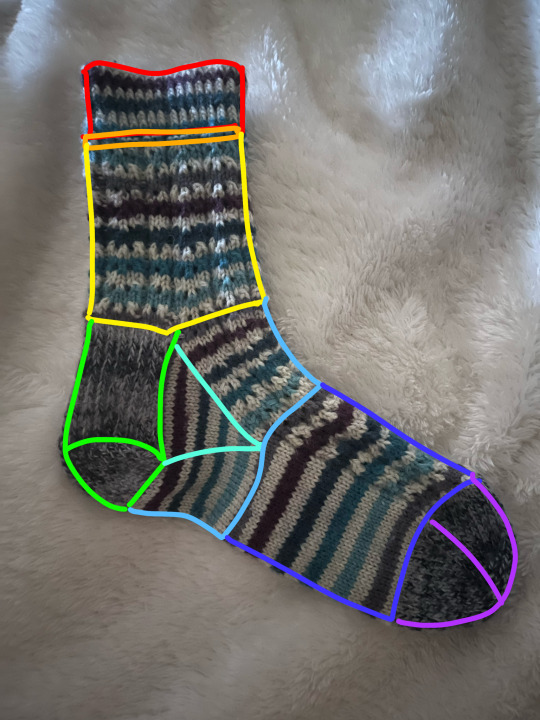
anyways, that's about all of my knowledge on cuff-down sock construction! my tumblr is lagging as I'm typing this, too many pictures I suppose?
hope y'all learned something or at least found this interesting, and have a lovely evening everyone!
(also, it won't let me add the video I wanted to, so it'll be left in the comments!)
#knitting#knitblr#knitting blog#knitters of tumblr#knitted socks#knit#knitting guide#knitted sock construction
101 notes
·
View notes
Note
I love your MLP infection AU! Genuine question, how would Starlight’s cutie mark removal spell/the Staff of Sameness factor into the AU? Since the infection is centered on Cutie Marks, could that be a cure/temporary solution of sorts? Or could the infection still latch onto the replacement cutie mark and cause the illness or even mutate it?
Starlight’s staff was given its power by Starlight herself, so she could most likely find another staff to cast her magic onto.
The only problem is that, if she ever gets infected, there are only two options: either she write down the spell so someone with powerful magic could replicate it, or the spell can’t be done at all.
And even if the spell can be done, it has its own issues.
For one, that would require taking away the personality and destiny of a pony. If no other solution ever comes, this could mean a pony living the rest of their life completely numb and colorless.
But that is the best case scenario.
While it is rare, a neutral cutie mark can mutate. This usually only happens if a person is already infected before the procedure, but it can also occur in ponies that have really strong magic or talents. This causes a subset of the Meanie Mark Virus, where a pony slowly loses color, distinguishing features, and, finally, all physical proof that they are a pony —this is known colloquially as “bleaching”. They do not die, and they aren’t aggressive, but they simply wander the landscape, looking for their lost cutie mark. These are known as Bleaches. Luckily, it is not contagious.
Another issue is how difficult removing a cutie mark of an already infected pony is. You can physically see black tendrils cling to the cutie mark, which leads to a magical tug of war that is not only excruciating, but can lead to the contamination of others. Powerful ponies, such as alicorns, the Mane Six, and anyone with great physical or magical strength, have an especially hard time removing infected marks. The pain can be so great in these cases that it can cause lasting trauma, damage to magic, chronic pain, and, in some cases, death.
The last problem is with the storage of these cutie marks. Would the virus fizzle out, like a flame without oxygen, or would it keep feeding in the magic of the cutie mark? What would happen if the marks happened to get out, even far into the future? If an infected mark has nowhere to return to (the pony that owned it died, for example), what would it do? Could another epidemic erupt if the case was uncovered hundreds of years into the future?
This could work, at least as a temporary solution, but it would require careful study and great caution.
#mlp#mlp infection#mlp infection au#mlp infected au#mlp horror#mlp starlight glimmer#mlp au#mlp fandom#mlp g4#mlp fim#mlp friendship is magic#digital art#artists on tumblr#art#my art#digital artist#fanart
37 notes
·
View notes
Note
This is probably a weird question, but what are some tips you could give on character design? I've been trying to feel confident with my own designs, but they feel kind of bland... what kinds of things would you suggest to help make designs stand out more?
Hoo boy. Hm. I feel like I am not the right person to ask about this because objectively I do almost nothing you're "supposed" to, but if it's working I guess that means I might be onto something?
A lot of my design considerations are practical. I don't want to give anybody a design that's going to be a nightmare to draw over and over again. I've done enough commissions in my time to know when somebody is overdesigned and therefore hugely annoying to draw, and that's a no-no. So I tend to stick with simple patterns at most, not too many layers, no need for five million belts, no need for incredibly intricate hairstyles, etc. This is a practical consideration for the medium of comic art, but other mediums have different considerations - 3D-modeled art, for instance, can overdesign the characters as much as they want because they only need to model them once, and a lot of visual novel characters are limited to a very small handful of poses and some interchangeable expressions, meaning it isn't prohibitively complicated to make them a little Extra. The most time-consuming and frustrating commissions I've ever done were for characters who were frankly never designed to be drawn more than once. A quick sampling of highlights for the design features I swore to myself I would never deal with again-



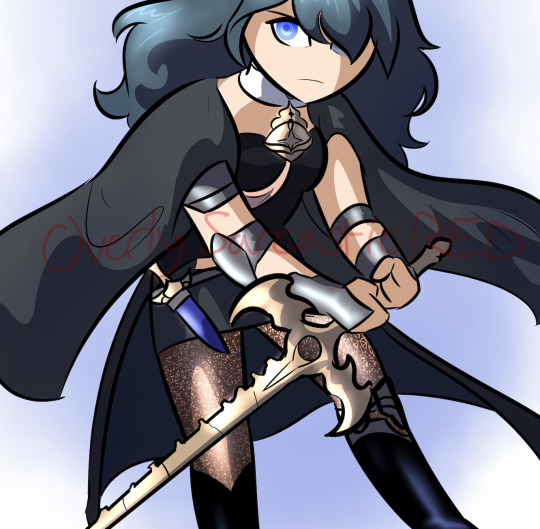

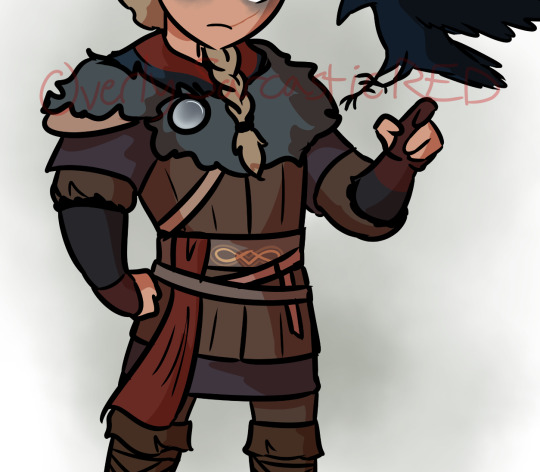
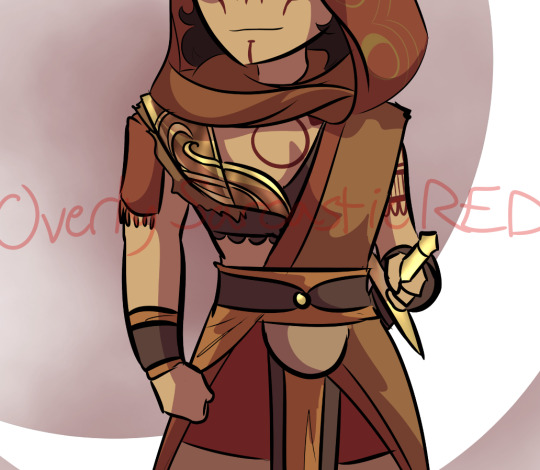




So on a basic level, if you're designing a character to draw over and over again, it needs to be something you're willing and able to draw over again. Intricate patterns, a lot of interlocking plates, anything with lace - those are all things I try to avoid.
I've often seen the advice that character silhouettes should be super visually distinct, that characters should be very strongly shaped like different things. I think that's great if your style is that flexible, but if you kind of want everybody to be shaped like a human being with a skeleton, this advice is not very useful.

I think a diversity of body shapes is great, but the style I favor requires the anatomy to at least sort of makes sense, which means while there can still be a lot of variation in the distribution of muscle and fat, everyone's bones are gonna be in roughly the same place. I can't just draw a square and fill it with a dude. So instead I try and distinguish my character silhouettes in other ways.
Everyone's hair is different, and because most characters have big hair, this plays a large part in their silhouette. Falst and Erin both have short hair, but Falst's is a bristling mane while Erin's is usually more swept and soft-looking. Dainix and Kendal both have long hair, but even when Dainix's hair is loose it doesn't hang or flow the same way Kendal's does - it gets in the way, drapes in front of his face and overall doesn't move the same. Alinua's hair is bouncy curls. On top of that, everyone's outfits are fairly simple, but no two of them are exactly the same - Erin has a monopoly on poofy sleeves, Kendal has cuffed boots and the back-slung sword, Dainix has the poncho and the poofier pants, Alinua has the v-neck top with slightly pauldron-y shoulders and the slippers, Falst's clothing is ragged at the edges, etc. Even without getting into their distinct color palettes, everyone's at least a little bit distinct.
And this is another place where I purposefully try to avoid overdesigning. If everyone has too much going on it can circle around to being hard to tell the characters apart, because too much is happening. Who can pay attention to the fact that one character is sleeveless and one has asymmetrical boots and one has a mullet when everybody is wearing eight layers of embroidered fabric with four belts and half a breastplate on top?
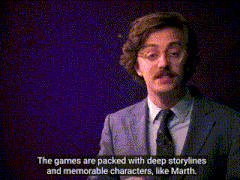
Avoiding same-face is hard, and I'm not very good at it. But I do try to make sure everyone's face shape, nose and eyes are at least slightly different from everyone else's. It might not show from a distance and it might not be as extreme as a pixar design sheet, but it's something.
Ultimately the main consideration I keep in mind when designing characters is - perhaps a bit redundantly - their character. Who they are as people, and how that will impact the way they look. Everybody stands differently, and shifts their weight differently when a situation is changing.
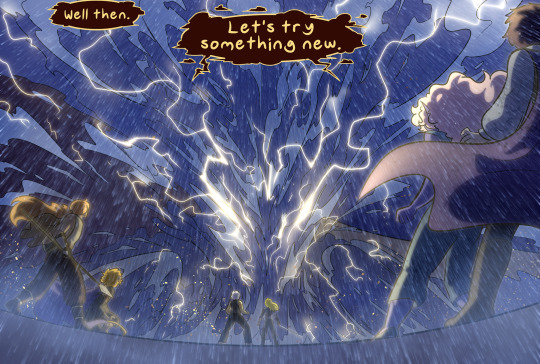
Despite both being short, lightweight guys with short hair, Falst and Erin are wildly different people and are not going to dress the same, make the same facial expressions or hold themselves the same way. Despite both being tall, long-haired, generally friendly warrior badasses, Kendal and Dainix carry themselves very differently and react to things in very distinct ways. Tess and Erin have the exact same haircut and nobody noticed for ages because of everything else.



The designs aren't complicated, and compared to some, they aren't even that distinct. But I try to make sure that their personality is visible in every aspect of their design. Every "why?" in their design has an in-character answer, and since they're all quite different on the inside, keeping things simple means that starts showing through on the outside.
This is also how I can visually distinguish between Vash and Kendal, who have the exact same body and clothes.



we can never underestimate the importance of ✨body language✨
391 notes
·
View notes
Text
Fake Ad: Galactic Melodies

A couple weeks ago, I reached out to @thecitybee to ask if I could use her work in a magazine project about transnationalism in Muslim music that I'd been working on with two other people for a class on Islamic pop music. Bee agreed to let me use her work so long as I gave her credit in my bibliography and included one of her socials in the finished product. So...voila! Above is the fake ad I created for a concert featuring Spock and Uhura and below is @thecitybee's original artwork, which was commissioned by the author of the fic that inspired it, @jolaosongoni:

When I saw this piece and recognized the kora in Uhura's lap, I flipped out. I love every chance we get to see Spock and Uhura play or listen to music together in TOS and SNW and this immediately sparked a lot of joy.
What I love most about this piece is that it places Uhura in a very specific cultural, familial and musical context, something that the Star Trek franchise itself hasn't ever really done. The kora is a West African string instrument widely played by griot families. Griots are musicians, storytellers and poets who preserve genealogies, oral histories and traditions of their peoples. The kora allows some griots to preserve these cultural histories through music and praise singing. While the practice of playing the kora has historically been passed down through patrilineal lines, there are women who play kora like Gambian griot musician Sona Jobarteh, who was featured on the cover of my group's magazine (she's a really cool musician, I highly recommend checking out her work). Star Trek doesn't have a great track record of giving their characters of color distinct cultural backgrounds beyond having them be played by actors of color (and sometimes, they don't even do that). Having Uhura be a kora player makes her an active participant in and carrier of West African history and culture, a living legacy of a particular and greatly honored line of musicianship. It intentionally creates her as a West African woman, or at least as a direct descendant of West African kora players and solidifies the cultural importance of kora playing beyond the past, present and into the 23rd century, celebrating Uhura's Blackness and African identity as things that are inextricable from her character.
Thank you so much to @thecitybee for agreeing to let me include your work in my own! You made a fellow trekkie and huge music nerd very happy :)
For anyone who's curious, here is a link to Sona Jobarteh's website:
#star trek#star trek fanart#nyota uhura#s'chn t'gai spock#west africa#kora#griot tradition#sona jobarteh#thecitybee#thank you so so so much for letting me use your piece!#black artists on tumblr
22 notes
·
View notes
Note
Hey! Could you write a love letter confession from TFP Shockwave to femme cybertronian reader? Like, what would the letter say once she opened it up and reads it? Have a good day or night! <3
TFP Shockwave x Femme Cybertronian Reader
Reader is femme, she/her
This is just straight up fluff
Reader frame type, paint job, optic color, etc. are unspecified
Thanks for the well wishes, hope you're doing well also 😊
Sorry the end kinda sucked, and that its so short lol, it was quite the challenge to write a love letter from Shockwave but I think it's good? Hope you like it.
-----------------------------------------------------------------
You've had a very busy day. As the only femme on the nemesis that is currently conscious, you have to walk around the ship, taking this to him or that to the other him on the other side of the ship. That isn't even the worst thing about this Pit forsaken ship either. All of the mechs tip toe around you like you're the plague. You feel so.
Alone.
The only bots that talk to you like you're friends are Knockout and Breakdown but they're gone most of the time. You honestly find Soundwave to be good company but you always get in the way while he's working. Megatron is respectful of you and actually likes to show you off to those who find their way on the nemesis. He told Optimus, er, Orion, all about you. And when Shockwave arrived he would not stop finding a way to brag about his, "elite femme".
Because of the pedestal Megatron placed you on with his words and reverence, Shockwave acknowledges that you are intelligent and competent. There are often times where he will share progress with you and even ask for your insight if something is troubling him. Your logic is somewhat fourth dimensional compared to his being third dimensional. Your logic often backed by your feelings rather than strictly being scientific. He likes hearing you say it too, "I feel like...", and then you give your opinion.
Your opinion is personal and he finds it rather refreshing. It's odd but he actually starts to like you, he will ask that you stay in the lab with him for just a bit longer or his servo will linger on yours when you hand him something. You don't notice that he likes you, to you, it looks more like he appreciates you; or that he's overworking himself. But then again, the lack of a faceplate with derma and two optics masks what he's feeling perfectly. Knowing the way he thinks though, you kind of doubt that he feels much of anything and if he does it's a very basic, diluted level of it.
Despite all of that, you find no reason to be suspicious of him or his intents, he always has plausible reasons for his actions so you don't ever question it. At least you didn't until you finally entered your hab. The lights flickering on as you stepped inside. Just a few steps to your left on your desk was a data pad and a small assortment of crystals. A couple, you realized, were of Cybertronian origin, the colors gave them a more distinguished look compared to the earth borne crystals.
You held one up closer to your face to get a better look at it before turning your attention to the data pad. You pick up the data pad with your empty servo, carefully twirling the crystal while the data pad glows. Your optics widen the more you read.
(Y/N),
The more I ponder, the more I am compelled to examine my thoughts and the feelings that come entangled in them, I begin to realize that, as inappropriate as it may be, I find you alluring. You are a femme of high caliber; you are intelligent, strong, above all, compassionate. I have seen it first hand, the way you interact with my predacon, and it makes my spark swell with pride. Your presence in the lab is one I have begun to look forward to. The distinct sound of your pedes is cause to increase efficiency in my work.
I have lain myself upon a slab and have taken myself apart, analyzing and experimenting to see just what exactly I felt about you. With time I have gotten the results I desired. The process was tedious but in the end I feel it was worth every step. (Y/N), I have a fondness for you and have chosen the most logical course of action regarding said fondness. Your frame is as desirable as your intellect and the softness in your optics after working so hard is truly a sight.
I wish to have you close to me. As close as you will allow. I understand you are more than just a femme, but a scientist and even a warrior with great honor. A femme who is worthy of respect. Thus, I leave the decision to you.
If you truly feel in your spark that you no longer wish to associate yourself with me I will not try to force you to face me. I will leave you be unless we must interact. I will bury these feelings and proceed with a professional attitude. But, if you are willing, I would like to try being more personal with you and share tender moments like I have observed from you and my predacon. Please, do respond to me in any way you deem fitting to your standards.
I patiently await your response,
Shockwave
You are at a loss. Shockwave? He really feels this way? Your optics snap up and you stare at the crystal in your other servo, everything has begun to click. Puzzle pieces falling into place.
The lingering touches, the long conversations, the slight change in his tone when he addresses you, and his requests for you to remain in the lab for even just a klik more. His entire demeanor changes when he speaks to you. Even if he is already calm, he gets even softer when he turns to you. It makes a smile creep to your faceplate. Your spark thumps in your chassis.
You can say that you do find the large mech to be attractive, his frame is strong, even for a scientist. His voice often soothes the dull ache in your processor after staring at the purple displays of the lab. So many thoughts race through your processor, you ask yourself a dozen questions. You look from the items in your servos to the rest of the crystals on your table while you continue to think. Finally, you turn your helm to look at your berth.
You decide to "sleep with it", or whatever human thing Knockout likes to say. As you begin to drift into recharge you make up your mind. You will reciprocate. You will tell Shockwave just how you feel as well. That you admire him and that you would trust no other mech with your most vulnerable self.
You're just not sure how or when you'll tell him.
#transformers#maccadam#macadam#macaddam#tfp#cybertronian reader#transformers prime#tfp shockwave#femme reader#cybertronian femme reader#tfp x reader#tf x reader#tfp shockwave x reader#shockwave x reader#fluff#tf#tf shockwave#bot!reader
239 notes
·
View notes
Text
Character Descriptions 101 (Or, the ugly truth about what really matters)
A lot of the appeal of being able to write your own book is being able to take all the characters you dream about and put them onto paper for everyone else to drool over as much as you do. You might create a character so iconic, they can be recognized by their hazy silhouette alone.
Not everyone designs Sherlock Holmes, though.
Not everyone needs to be Sherlock Holmes.
How well you describe your characters, especially your protagonist/opening narrator, says a lot more than you’d probably like about your experience as an author. I’ve got eight years of practice with my own works, twelve if you include my early days of fanfic – and resisting the urge to describe characters in the tried and true clichés is still hard.
So here’s the ugly truth about describing your characters, and some other pointers curated from the Internet you may have seen before.
At the end of the day, what is really important?
Unless you are writing in the genres of fantasy or sci-fi, or you aren’t writing humans, your character will likely be a very average looking human. Doesn’t matter if you think your special bean’s black hair/blue eye/snow white skin combo is unique – is the shape of his face, curve of his lips, how wide his shoulders are really that important outside of, I don’t know, a steamy romance novel?
I ask this because character descriptions fall into three camps: Thematically important beats, thematically unimportant beats, and “oh damn I have too many blondes, uh, here’s a redhead” beats.
I ask this, because “this character doesn’t look like they did in the book” arguments will never stop happening and we all have our sides on what matters and what doesn’t.
These details can be height, hair color, eye color, skin color, hair style, clothing, tone of voice, accent, birthmarks, scars, and tattoos, and anything in between. Sometimes, this trait is this person’s defining trait. Sometimes, the author just felt like it – sometimes the curtains are just blue.
But sometimes, a lot of times, they’re not.
My two cents: If that piece of their design is thematically important, the adaptation should respect it and include it. If it’s not, who cares?
Thematic Character Design
Thematic character design is the intent behind the choices the author makes when deciding how they will present their character to the world. This is *why* the character looks the way they do.
Visually, you see this in anime all the time. Crazy hair colors and styles help distinguish the cast when their faces might otherwise be too similar, or when drawing them from a distance. Sometimes the protagonist will have the most unique, or the loudest hair style (think Yu-gi-oh). Or the Important Lady Character will have pink hair. Or the sad angsty anime boy will have white hair (see my post about color in fiction).
In the written medium, you can “show don’t tell” a few different ways cliché ways:
Give the villain a facial scar
Make your femme fatale a redhead
Make your hero blonde/blue-eyed
But hey, they’re tropes for a reason, everyone knows what you mean when you write them. You might give your character green eyes like their mother, a trait Very Important when a redeemed-ish villain dies. You might give your character a brunette French braid that goes on to become the style of the rebellion. You might make your Illegal Divine Children the only three black-haired major characters in a sea of brown and blonde because they are the Three Illegal Divine Children. You make all your grisled fantasy men have beards and your elves clean shaven.
The existence of these traits serve the plot and the themes of the story. It matters because these traits make them look like the villain, or the dead legacy they must live up to. These traits ostracize them from their community, or help define their culture. These traits are the hallmark of a chosen one, or a pariah. These traits are emblematic of a special power or handicap, religion, faction, rebel cause.
These are the details fans complain about when adaptations get it wrong, and it’s not without merit. But what happens when those details aren’t all that important, no matter how much you think otherwise?
Unthematic character design
Everyone lost their minds when Hunger Games was being adapted and to everyone’s unnecessary horror, Jennifer Lawrence is blonde. Everyone got mad because it’s the little details you have to get right, otherwise you’re disrespecting the source material, yada yada. Is it really so hard to wear a wig, if you can’t get this tiny thing right, what else will you mess up, etc.
Question: Was the color of her hair more important, or the style that it was in?
She dyed it anyway to stay faithful, but which detail mattered to the plot, versus just being what the author picked for her?
Dare I wade into the “this character was white in the book” cesspool? Reluctantly, yes. And all I will say is this: Does their skin color serve any legitimate purpose to the plot or how they define themselves? No? Then shush and let the actors do their thing.
… But what if race *does* matter?
Is this a slice of life novel about some plucky high schoolers in your average American town? If the story isn’t any deeper than prom dates and football games, the skin color of your character is not important. Is this a treatise on segregation and the struggles of womanhood in repressed societies? Then yeah, the skin color of your character might affect their outlook on life a little bit.
In other words: Does your character care what they look like, and does their appearance affect the trajectory of the story?
Yes, it’s disappointing when you see your favorite character on screen and have to be told that’s them because it just doesn’t look like them. But what’s important is if they fit the spirit of the character, even if they don’t quite match their looks (a lesson I, too, need constant reminding of).
Character Descriptions in Fantasy and Sci-Fi
If making sure the adaptation stays faithful to the character design matters anywhere, it’s in these two genres. Why? Because you have free reign as an author to describe your mythic creatures, your aliens, your supernatural entities however you choose, and you worked hard trying to make them distinct from every other fantasy series out there.
But hold your horses on how specific you get.
Generally speaking, the traits that most authors describe first are hair, eye, and skin color, because it’s the easiest to get out of the way and everyone knows what humans look like to fill in the blanks. When you enter the realm of non-human characters, you have a lot more legwork to do to make sure your audience imagines what you want them to.
Maybe they have slit pupils like a housecat or a snake, or they have really floppy elephant ears, or they have antennae that twitch when they’re angry, or they have wings like a bat, a bird, a dragonfly. Or they have distinctive tattoos from their tribe. They have scales or feathers or fur and you want everyone to know how fluffy it is. You want your audience to know how tall they are, how heavy, how lanky, how robust. The shape of their face, their hands, if they have fingers like a pianist or a catcher’s glove.
Or, it matters because you’ve written an allegory on race, class, colonialism/imperialism, a World War, Apartheid, what have you, and your made-up nationalities need their own traits to be bigots about.
Answer: Hire a sensitivity reader before you design an insulting stereotype.
Otherwise, feel free to add as much fluff as you’d like. You go out there and you give exact measurements, constant similes about the textures of their skin, write an essay on cultural wardrobe, take two paragraphs to describe that ballgown and masquerade mask… and accept the fact that your readers will happily go SKIP!
Because description and exposition are also entwined with tone and the purpose of the story. I am writing an 18th century royal ball scene in a steamy romance novel and my hero is about to get her man – my audience might care about things like a sweetheart neckline, perfume, what kind of flowers are in the lacework, how it hugs her body, how the pink looks so damn sexy in the candlelight, how the skirts sweep so elegantly, every piece of jewelry she's wearing and how expensive it is and exactly how she did her hair.
Or, I am writing a fantasy adventure that happens to feature a pitstop at a royal ball – Your audience does not give one flying f*ck about what flowers are on that dress. Describe the color and something cool and eye-catching and move on.
The Ugly Truth: Does. It. Matter?
You can wax poetic about the minutiae of your absolutely unique and like no other fairies no one else has ever written before. Maybe you designed them less like Tinker Bell and more like anthropomorphised flowers – that matters!
You want your hot love interest to have a cupid’s bow and to remind the audience of that detail at least four times throughout the narrative? Not important unless the narrator is weirdly obsessive over it (or, again, romance/erotica).
The same thing goes for fantastical settings.
At what point are you describing the color of the grass, the kind of marble in the walls and floors, the exact shade of blue paint they used, the gables and the roofing tiles and the scalloping on the columns to unnecessary ends?
This also affects pacing.
If your entire story is set in a beautiful castle and the heroes never leave? Describe as much as your little heart desires. Is it just a pit stop on the way? Call it a castle, maybe it’s in ruins, give one uniquely defining trait that’s thematically relevant, and move on.
Side characters too: If you don’t even bother naming the poor schmuck, give their gender and maybe one fun fact and move on.
You’d be surprised how little character descriptions, or lack thereof, are even noticed. The amount of fanart head-cannoning a character being Not-White because the author technically never clarified is everywhere. I just reread the first two PJO books and Chiron’s human half is never described beyond his age and his beard. Everyone who read it filled in the missing details with what they wanted or expected to see and that doesn’t impact his character one bit.
Pacing your descriptions
See this post about how to pace your narrative.
Everyone knows the trope of the narrator waking up, gazing into a mirror and describing themselves to the audience. It’s cheap, it’s fast, it’s dirty, it’s effective.
So why do people hate it?
I think it’s less because it’s overdone, and more because it’s robbed of potential. When I wrote about pacing, I said every scene should be pulling double duty – character descriptions fall under exposition, and should do the same.
If you really want to have your hero describe herself to you via mirror, don’t just write a textbook, give it flavor. Is she self-conscious about her looks, saying she has choppy blonde hair but wishes it was some long, luxurious brown like some girl she’s jealous of? Does she have a big nose and wish it was smaller because she’s bullied? Or, does she love her green eyes, because her late father had them and she loves the connection they share?
Good pacing isn’t about how many or how few words you take to describe something, it’s how efficiently you use those words. Short doesn’t always mean it’s bland, long doesn’t always mean it’s profound. Don’t take 300 words to say something that could be said in 30 – but some things do deserve 300 words.
Examples:
A: She woke and rolled out of bed and stared at herself in the mirror. She had hazel eyes and blonde, curly hair that she pulled up into a ponytail.
B: She woke on the third alarm and rolled out of bed. Staring back at her in her vanity were tired hazel eyes beneath a mop of dishwater blonde curls and crease marks from her pillow.
C: She woke on the third alarm and dragged herself out of bed. Her vanity mirror glared back at her – a rats nest of dishwater blonde and crease marks from her pillow. She scowled and rubbed the sleep from her hazel eyes and raked her curls up into a messy ponytail to be dealt with after coffee.
Or, go even longer, really weave those details into the action of the scene, I didn’t here because this is a blog, not a book.
No matter what, best practice is to not infodump the description, spread it out – another criticism of the mirror trope. There is no one size fits all for any writing advice but if you’re spending more than four consecutive sentences describing a single character, object, or building, break that hot pile of exposition up and look how much better it reads.
Similes for describing your character, like any comparison, should serve a purpose. Think about describing an intimidating queen with snow white skin versus bone white skin – what vibes do you get from one simple word change?
You have a long time to describe your narrator, it’s okay if we don’t know what they look like on the first page. Give the details as they become relevant. If you open en media res and the hero is in a nasty fight scene – describe their hair as it flops in their eyes, describe their skin as it’s covered in sweat or scratches or bullet holes, describe their eyes as they patch themselves up and one is now black and blue – or describe their color full of fear, hate, malice, grief.
Describe them against another character so you get two birds with one stone. Whether the narrator is jealous of, attracted to, or appreciative of their fellow character’s appearance. Describe them self-conscious about trying to impress a crush, their spouse, a superior, interviewer, parent, the public, the press. Or describe them unhappy about how they’re being forced to look compared to how they usually are, e.g. a school uniform, prisoner’s uniform, fancy dress/suit, skimpy undercover costume, bargain bin, ugly hand-me-downs, holiday costume, sleepwear, full face of makeup, or no makeup.
All of these are motivated details that will read better than halting the narration to drop textbook lines of exposition.
Lastly, do not let your characters get side-tracked describing themselves when they have more important and prescient concerns. In the above hypothetical fight scene, a “she swept her blonde hair from her eyes and got back to her feet,” is going to read smoother than “she swept her blonde hair aside. It was short and choppy, cheap highlights fading and flyaways tickling her face. She got back to her feet.”
And even then, personally, I think this reads better still: “She swept her hair from her face and got back to her feet, sweaty blonde tangles stuck to her skin.”
Have intent, make it motivated, and the less it feels like awkward exposition.
Pitfalls to avoid
Full disclosure, I am white, from a long line of the whitest white Europeans. I do not write a pasty white cast of characters. Boy, was it an eye-opening experience realizing how harmful my earlier descriptions used to be, just from the books I grew up reading and through no ill-intent of my own.
So another detail in the realm of “does it really matter”: Not all brown skin is the same shade of brown, but resist the urge to compare it to any flavor of food or chocolate. I just reread a favorite kids’ book of mine and saw “chocolate milk” and as a kid, I never noticed or cared, but you bet I zeroed in on that little beat as an adult.
Is this hard? Kind of, yeah. I suppose you could go scorched earth with the food comparisons and describe all your characters in their flavor of milk. Pale skin has a lot of options: Snow, frost, paper, bone, fair, pale, lily, sandy, fawn, etc. and of course, milk, cream and sugar to boot.
The “brown skin like milk chocolate” is tempting, but dehumanizing particularly when only brown characters are described with food. Decide if the exact shade of brown is important, then get respectfully creative with the comparisons. The same goes with hair styles and textures.
Related to skin color: Be careful with what idioms and metaphors you use when describing characters who aren’t supposed to be white, doing things only possible or noticeable with light skin.
A certain famous author really tried to tell the world Hermione wasn’t *technically* white and the HP fans went and pulled page numbers proving that she has to be based on the behavior of her skin.
I’ve caught myself (and had to be told) a few times describing a not-white character “white-knuckling” something as shorthand for being stressed and tense. Faces blanching, paling, reddening, blushing, turning green, looking sun-burnt and bruised and scarred all look different depending on how dark their pigment is.
I am not at all an expert on what you *should* do for non-white characters so I will say this once again: Do your research and get a small army of sensitivity readers. Even if you don’t think you’re being racist, you might be. Accept the constructive criticism, and change it without complaint. Do not lie down and die on a milk-chocolate hill.
The Beautiful Truth
In the written medium, unless you canonize character art and take no constructive criticism, all your audience has to go on is suggestion. That means that your audience has the freedom to imagine their favorite characters however they want.
That means you get a million variations of the hero in their fan art – that’s amazing! If you never described the protagonist’s skin color? You get an audience that makes him or her or them the hero that they want to see and how you’ve inspired them – that’s amazing!
That’s what I mean when I ask if it really matters. You will always know how your literary darlings look. Is it more important that everyone else draws a million different paintings in their mind of the exact same face like a photocopier, or that you now have an audience giving you a million unique paintings of your life’s work immortalized in the grand literary canon?
#writing advice#character design#character development#exposition#writing resources#writing tools#writing
44 notes
·
View notes
Text
wip I'm working on about Rain being dried out and not knowing how to care for himself topside since he's had no water ghoul as a mentor.
Sfw, might be body horror (its super light!), ghouls caring for each other.
Rain’s doubtful, and he’s not really in a position to say no. Something prods at his head, something that’s like pins and needles. His skin feels charged with static. It hits, and the aching tension in his skin is gone, but he doesn’t like it. Rain fights this foreign feeling in his head and thrashes like a fish on a line. He's terrified. He's so vulnerable, and he can't see what this person is doing. The feeling is too foreign, and if he could shout for him to stop, Rain would. Immediately it’s gone.
“Okay. Okay. So none of that.” The person groans and there’s shuffling as he kneels. The towel at Rain's neck is shifted and tied loosely around his throat. There’s more shuffling and suddenly sharp claws are pressed against him, though on the dull curved side. “I’m going to tear this shirt off. Sorry. Then we’ll get these wet too.”
Rain can only assume he means his gills along his ribs. The towel is starting to feel just a bit too dry against the delicate membranes, and he wants to thrash again, but a large hand that’s much cooler than the fire he felt earlier holds him still.
“M’not gonna hurt you.” The voice says as he feels his skin exposed to the dry air and the sound of fabric tearing. Rain can only really tense his fingers in agony. Every breath feels like hell.
There’s footsteps, large heavy ones, and a smaller steps following.
“The bath’s ready, Aeth.” The voice is deep and rumbling like before, though it sounds a bit mumbled now.
“Okay. I can lift him but he squirms. Mind helping?”
There’s a silent exchange Rain can’t make out and suddenly there’s hand on him. Two at his shoulders and one under his back and hip. They lift him up and immediately Rain doesn’t like it. Not being able to see makes him feel ill as they situate him. They’re trying to help, he knows this, but the touch of their hands makes bile rise in his throat. Not that he could vomit anyways, his lips are stuck shut.
The two carry him and halfway through Rain gives up fighting. He hears the change in scenery, going from large and dampened to small and echoing. Voices bounce off tile and the footsteps sound louder.
“There’s going to be some water. It’s a small tub.” The smaller voice tells him as his tail touches something cold and wet. Slowly he’s lowered into it first from his feet and then to his shoulders. He flinches when the hands leave almost afraid he’ll keep sinking, but his ass smacks the bottom and leaves his head afloat.
Rain sinks lower and frowns when his knees are exposed to the air so that his head can sink. Immediately he can feel his dry skin loosening. Some of it comes off in large scales and his fresh skin all but sucks in the water. It’s more comfort than he’s felt in weeks.
His face finally frees and he opens his lips first. Then his eyelids finally release and he can see. The light is an assault on his eyes and he quickly closes them again with an image of the bathroom stuck behind his lids.
Voices above him reverberate to the water. They’re muffled but he can distinguish them. Slowly he opens his eyes to make out the distorted figures from under the water.
One of them is a large man with several peircings in his ears. His hair is short and well trimmed. A dark chinstrap beard lines his jaw. Rain can guess that's 'Aeth' from the thick dark bands around his fingers.
The other is taller than the rest. He’s lanky with defined features of an underbite and a prominent nose. His thick hair is tied in a low bun, but what catches Rain’s attention is the color of his horns. They’re white and black, the inverse of each other, but maybe that’s a trick of the water.
The shortest one has long platinum hair pulled back over his shoulders. It blocks most of his face, and Rain can only see him once he turns around to glance at the tub. It must be Dew. His footsteps sounded lightest.
His nose has a bump in it and it looks crooked, but that’s hard to tell under water. It looks like he’s been through more than one fight. What’s terrifying is the black scarred thin flaps of skin on his neck. Rain’s gills flutter seeing it and close against his own skin. They cause little ripples of bubbles in the water, and the big one with the rings looks towards the water.
“Feeling better, fish?” The shorter one slaps him in the chest and he lets out an oof. “Sorry, Rain. I'm sorry that we didn't catch this sooner, it's just that none of us knew.”
It's not his fault, and Rain knows that. He should've known too, but he didn't know what the strange feeling of his skin meant until it was too late. Slowly he comes to the surface of the water laying on his side trying to keep as much of himself submerged as possible. His tail makes small languid movements in the water. He pokes his eyes out without blinking, just letting the water drip off his eyes, which is more relieving than it looks. It’s a bit unnerving for the tall one who visibly raises his shoulders.
“S'okay,” he says with water bubbling at his mouth. Dew laughs a bit before his face drops again.
“How’d you get so dried up?”
The question sends Rain dropping back to reality. The reality that he’s not among his old pack, that he’s not among fellow water ghouls. That these people smell like dirt and smoke and oddly cranberries. They don’t smell like saltwater and sand. They have two tone horns, and rings that fit on web-less fingers. They have blonde hair instead of dark black. They aren't like him.
43 notes
·
View notes
Text
Stop making 8-episode seasons
When you look at why people complain about shows in recent years, so much of it boils down to a couple of issues issues:
- The pacing was inconsistent/the pacing lot felt rushed
- The audience couldn’t connect enough with the characters to care about what was happening
Why is this?
It’s because when a show has only 8 episodes, there isn’t enough wiggle-room to properly flesh out ideas and characters.
Take Avatar: The Last Airbender on Netflix. Only 8 episodes! The first season of the animated series had 20.

But MrRyckman, the animated show’s episodes were much shorter!
Timewise, the animated show’s first season came to a runtime of about 7 hours and 34 minutes, compared with the live-action’s 6 hours and 22 minutes, a difference of over an hour in runtime. That is not inconsequential, even if you cut the plot of a few episodes (which they did).
The other issue is that, whereas animated shows tend to dive right into the action (because animation allows for unique character designs and bright colors that makes it easier to distinguish things), live action shows tend to take their time. They introduce characters more slowly, take time to introduce more intricate plots, and use a fair bit of time to wrap things up. That results in a *lot* less time to replicate the same elements without just doing a 1:1 adaptation (which in this case would be extra-weird).
What makes shows memorable?

Shows become memorable when audiences connect with the characters, and this cannot happen when every season of your show has to be intensely plot-focused. Look at popular shows like Supernatural - each season of that show had between 16-23 episodes, most of which were around 40 minutes long.
Because each season had approximately 800 minutes to tell a season-long arc, Supernatural was able to have character-focused episodes where little plot happened. As a result, audiences connected with Sam and Dean (and Castiel. And Bobby. And others!) more!
This isn’t to say that all shows with shorter seasons are terrible. In fact, when the writers know what they are doing (or are adapting a work that can fit nicely into that timeframe), shorter-seasoned shows can become popular, too!

For the first 4-5 seasons of Game of Thrones, the showrunners were very adept at balancing plot and character moments. Heck, there were *tons* of characters that audiences connected with, far more than other shows with longer seasons, and yet audiences had no trouble connecting with them because the show was well-written. It gave us time to know the characters and understand more than just their basic motivations, and kept putting different characters together to show unique interactions that contributed to the show’s popularity.
Then the showrunners decided they were tired of GoT and cut it short. Despite the fact that HBO was more than happy to give them several more 10-episode seasons, they ended it at Season 8 and cut the final two seasons to just 7 and 6 episodes. Because they had to get to a predetermined ending, they rushed the plot, resulting in character assassinations and fast-travel of a sort that even the Dragonborn would be jealous of. And all at once, the collective consciousness of the Internet doomed the show to die just about as soon as it had finished airing. The shortened seasons didn’t help it - they actively hurt a show that had taken the attention of millions of people.
Why the shorter seasons now?
So if we have examples of long-running shows with huge fandoms (meaning more people willing to spend money on products related to said fandom) and an example of a show that ruined its reputation with two shorter seasons, why are 8-episode seasons suddenly the norm?
It’s a combination of multiple factors. For starters, networks are trying to make higher-quality shows to capitalize off what they saw as the successes of shows like Game of Thrones. Bigger set pieces, more CGI elements, big-name actors, all of which means more money. Instead of many low-budget shows, we now have a case of several big-budget shows. But in order to maintain that level of quality throughout, there have to be fewer episodes.
There are other factors as well (the popularity of binge-streaming, the fact that networks no longer have to care about syndication and reaching 100 episodes, to name a few), but overall, it is clear that networks seem to think that 8-episode seasons are the way to go.
Do I hope that the rise in negative reviews with shows like The Acolyte or the last two seasons of GoT will maybe force networks to reconsider this model and give us longer, better-developed shows? Absolutely. But I’m also cynical enough not to think they will.
#supernatural#natla#atla#netflix avatar the last airbender#avatar the last airbender#game of thrones#the acolyte#seriously but can we just get a redo on those last two seasons of GoT?#or at least a retcon pretending it didn’t happen#give us the longer shows you cowards#pretty much every Disney show now is short and terrible
17 notes
·
View notes